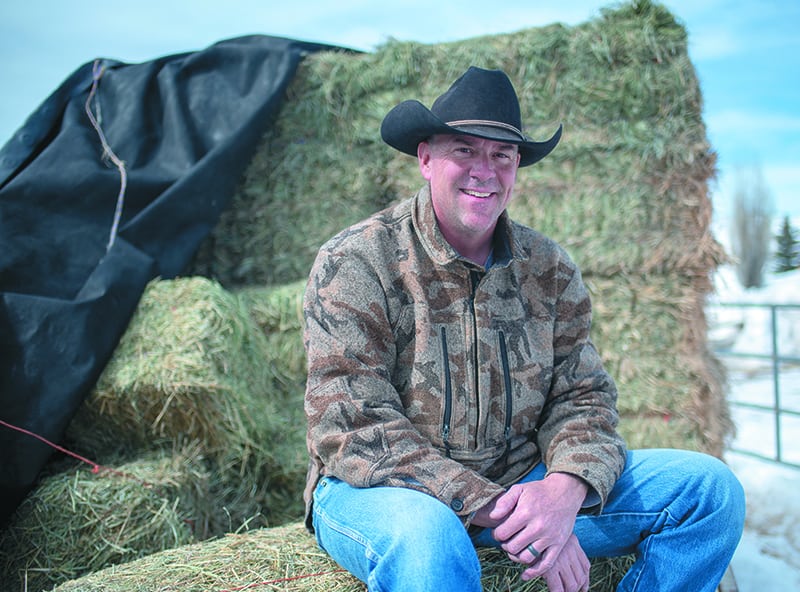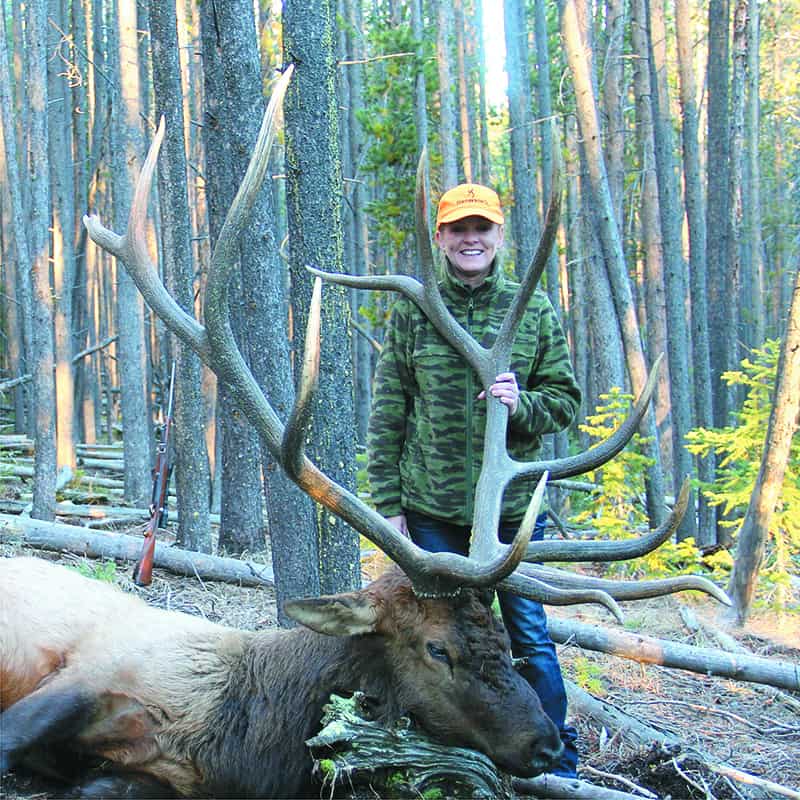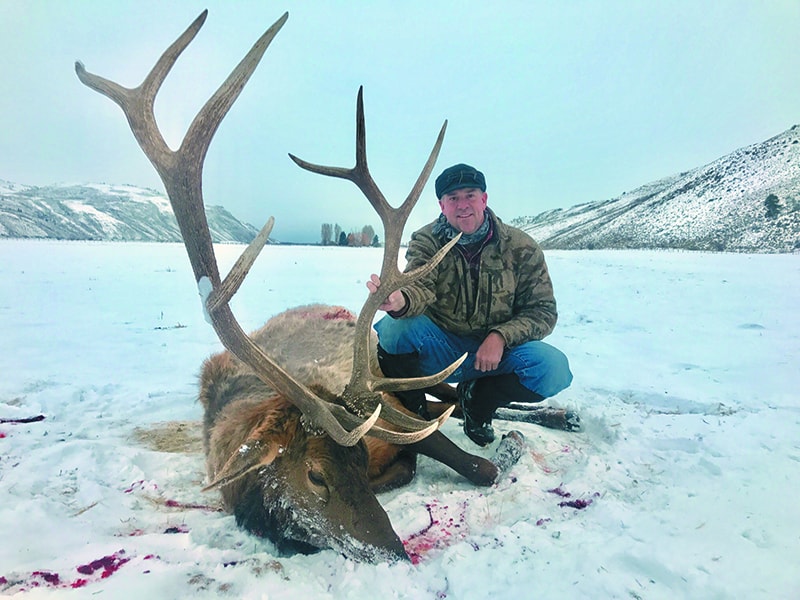Read The
Current Issue
Home in the High Country
Big-game hunting guides flock to the subalpine each September, and often don’t pack it up until the snow stacks up.
By Mike Koshmrl

Hunting outfitter Carlton Loewer. Photo by Bradly J. Boner
INCESSANT CUPS OF Jetboiled coffee color Carlton Loewer’s memories of his first time leading clients to a bull elk. The scene played out for the veteran hunting guide more than a decade ago, but it’s crystallized in his mind like it was just the other day. Loewer, who is Louisiana-grown, had a few years under his belt working out of C4 Outfitters’ backcountry Granite Creek camp on the southern flank of the Gros Ventre Range, but he had been relegated to horsepacking and grunt work. Employed by his late father-in-law, Sam Coutts, Loewer climbed from the bottom of the ranks, and by year five was staring down his first day of solo guiding, which came in the aftermath of an early-season snowstorm. The fresh sheet of white in the high country allowed him to spot with his binoculars a “whole big ole group of elk” bedded down on a mountainside bench over a mile away.
“My first solo guiding trip I filled both of them out in a span of about 45 seconds,” Loewer says. “It’s something I will always remember.”
The two, coffee-slurping North Carolinian clients Loewer was leading weren’t exactly Daniel Boone and Davy Crockett. One of the men was underprepared, underdressed, and chilled to the bone. He broke out his portable Jetboil stove to heat water for coffee every time they stopped, even as the elk—their whole point for being there—were in view. “I let them finish their cup,” Loewer says. Coffee down the hatch, the hunters followed their rookie guide on horseback, finally dismounting to gain a ridge on foot for a sneak attack from above. Unseen by the elk, they closed to within 150 yards, but discovered only a “raghorn”—hunting lingo for a smaller-than-desirable bull whose rack has fewer than six points on each side. But the client who had been freezing for three days because he didn’t bring enough clothes didn’t care. He killed it and, at the sound of his rifle, a whole group of nearby elk stood up, including a 6-by-6-point bull of trophy proportions. (Trees had obscured it.) The other client’s rifle barked, and, just like that, Loewer’s first two clients had notched their tags. “My first solo guiding trip I filled both of them out in a span of about 45 seconds,” Loewer says. “It’s something I will always remember.”
Loewer got hooked on guiding early in his outfitting tenure. “Once it gets in your blood, it kind of stays there,” he says. The 45-year-old’s path to residing in Hoback and guiding hunters in pursuit of buck mule deer and bull elk each fall is objectively atypical. Standing a sturdy 6’6”, Loewer is a former professional athlete—he was a starting Major League Baseball pitcher for the Philadelphia Phillies and San Diego Padres. He ended up in northwest Wyoming after meeting Coutts’ daughter, Cathy, while playing ball in Southern California. He and Cathy began dating in the early 2000s and moved to Wyoming while he was recovering from an injury, but still trying to mount a comeback in baseball. A lifelong hunter—Loewer grew up chasing white-tailed deer at his family farm in southern Louisiana—he quickly began helping Coutts as a “packjack” for C4. He slowly eased into managing the outfitting business, before taking it over entirely when Coutts died in 2015.
Because the primetime season for most professional hunting guides is only about two months long, Loewer filled the other ten months of his year first with odd jobs like carpentry. Now he is a Realtor with Sotheby’s, which he got into through Cathy, who is also a Realtor. “We had a kid, and she had to refer a client to another agent in the office,” he says. “She goes, ‘If you had your license you could have taken that.’ ” Soon after, he filled out the paperwork.
LOEWER’S C4 OUTFITTERS is one of a couple dozen outfitters that set up camp each fall in the highlands that surround Jackson Hole. The Wyoming State Board of Outfitters and Professional Guides lists seventeen accredited outfitters with a Jackson, Wilson, Kelly, Moran, or Moose address. Still other outfitters come from outside of the valley and set up shop here every fall.
Statewide, the outfitter business is thriving, Wyoming Game and Fish Department commissioner Mike Schmid says. “I just saw some posts that said guides are already booking hunters in 2021 and 2022.” Some Wyoming regulations are specifically geared toward helping outfitters, including one that requires out-of-state hunters to hire a licensed outfitter for any hunt in designated wilderness. In a place like Teton County, where there are parts of four wilderness areas—Teton, Gros Ventre, Jedediah Smith, and Winegar Hole—this means that if you’re a nonresident and want to go backcountry hunting, you have to hire a guide.
BY ALMOST ANY measure, hunting outfitters have a tough gig. Clients can be needy, picky about the size of animal they’ll settle for and—as with any other high-dollar client—can demand tip-top customer service. (A week of backcountry hunting is often $5,000, and can be much more.) “I try to think about it like, ‘This is this guy’s vacation,’ ” Loewer says. “He’s typically taking days off, he’s been saving up preference points or saving up to be able to afford the hunt for years and years. So I want to make it everything it can be for that person.”
A day in pursuit of elk or mule deer in the backcountry typically starts around 3 a.m. for breakfast. Then there’s often a one-hour-plus, predawn horseback ride so clients can be positioned in honey-hole basins and drainages known to hold game as the sun rises. Aside from the early hours, there’s also the inherent danger of being around horses—Loewer has had a few clients injured in accidents over the years—and the hazards that come along with sharing a landscape with species like grizzly bears. It’s extremely physical work, too. Although mules and horses do the bulk of the heavy lifting by hauling guided hunters’ meat out of the backcountry, the task of gutting and quartering (removing the limbs) a 500-plus-pound elk can make anybody sweat, even when temperatures are below freezing. Then, of course, there is the knowledge base that’s a prerequisite to even attempting to guide.
When a hunter does harvest, it’s redeeming. “When you see that smile, and the pictures and the hunter gets to go home with the meat, that’s the beautiful part of the job.”
— Outfitter Carlton Loewer
Guided hunters typically kill something. Loewer doesn’t keep a running calculation of his clients’ success rate, but says their odds of shooting an elk or deer are higher than do-it-yourself hunters. But the nature of Mother Nature is that not every client gets an animal. Sometimes it just doesn’t work out.
When a hunter does harvest, it’s redeeming. “When you see that smile, and the pictures and the hunter gets to go home with the meat,” Loewer says, “that’s the beautiful part of the job.” Some of the elk C4 Outfitters clients have tagged are true memory makers—and even record holders. One of Loewer’s former guides, Terry Fieseler, once led Jackson resident Trish Williams to a bull elk whose rack’s beams and tines scored out at a 395 typical animal using the Boone and Crockett Club scoring system. That score easily surpasses the 360 points necessary for an entry into the club’s awards books, and the animal’s antlers were far larger than those of an average-size mature bull elk. This burly elk had frequently shown up on remote game cameras set on private land in the Bondurant area that C4 Outfitters monitored. The cameras caught this elk several summers in a row, but then, each fall during rifle-hunting season, he always became a ghost. Williams—with the help of Fieseler—finally got lucky. “It was like the No. 2 bull ever killed by a woman in Wyoming,” Loewer says. “Anytime you get to take a trophy of that magnitude, it’s a pretty special experience.”
Loewer also cherishes the experience when his clients harvest more typical animals, and even the times when luck isn’t on his and his clients’ sides. “The guys that have hunted before are usually understanding,” he says. “I’ve had great hunts where we don’t kill anything.” What makes it easier is that most of C4 Outfitters’ clients are known commodities. “I have the luxury of being a little bit picky and being able to choose the hunters I want to take,” he says. “A lot of my clientele are return clients just because I like hanging out with them.” C4’s clients are predominantly out-of-staters who come from places like the Midwest, Texas, California, and Florida. “I’ve got one woman who’s been hunting with us ever since I moved here,” Loewer says.
As C4’s client base has aged, it has adapted. At the turn of the century, some forty hunters cycled through the Granite Creek backcountry camp in a season that ran from early September through the end of October. “That’s when we had five guides and a cook,” Loewer says. “Now it’s probably down to fourteen, sixteen clients and right now it’s just me guiding.” The backcountry camp was sold to another outfitter, and now Loewer exclusively uses leased private land in the Bondurant area.
One of Loewer’s standout memories from this past season had little to do with hunting. He was with an archery hunter and on a lunch break in Pinedale when the Roosevelt Fire near the Hoback Rim flared up, severing their route home. The duo did the slow-going, mountain drive over Union Pass—a first for Loewer—to Jackson Hole, but, even once back in the valley, they couldn’t get to C4 Outfitters’ lodges, where the client’s gear was: The highway between Jackson and Bondurant was closed because of the fire. “He ended up having to fly out in his camo,” Loewer says with a laugh.

Trish Williams, of Jackson, shot her record bull elk near Bondurant with C4 Outfitters. Courtesy Photo

Loewer with his six-point bull elk killed while hunting Spring Gulch outside Jackson. Courtesy Photo

Loewer packing a bull moose out of the woods. Courtesy Photo




